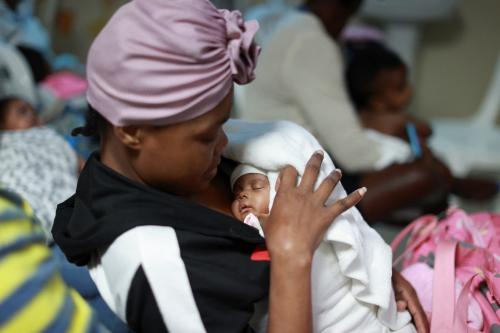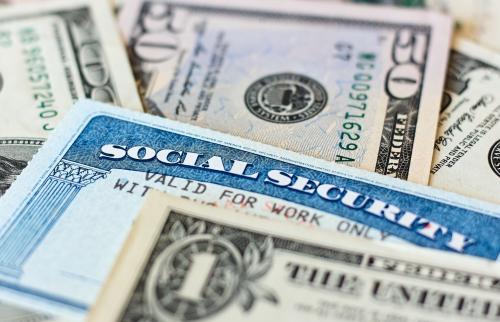This analysis is part of the USC-Brookings Schaeffer Initiative for Health Policy, which is a partnership between Economic Studies at Brookings and the University of Southern California Schaeffer Center for Health Policy & Economics. The Initiative aims to inform the national health care debate with rigorous, evidence-based analysis leading to practical recommendations using the collaborative strengths of USC and Brookings. This piece originally appeared in Health Affairs on December 15, 2021.
Health and mental health providers, including the American Academy of Pediatrics, are warning that US children and adolescents are facing a mental health state of emergency. Well before the COVID-19 pandemic, rates of many behavioral health conditions affecting children and youth had been escalating. In 2018, suicide was the second leading cause of death for youth ages 10–24. The proportion of all emergency department visits for kids related to mental health increased substantially in 2020. Use of services related to intentional self-harm, substance use disorders, and other mental health conditions also increased since the start of the pandemic. Too many youth—more than 48,000—remain confined in facilities away from home because of juvenile justice or criminal justice involvement. Urgent action is clearly required to help America’s kids.
The pandemic has created additional financial stress, loss of loved ones, and educational and social disruptions for many children. For the more than 12 million US children who live in families with incomes below the poverty line, there are additional pressures that can reduce health and well-being, including homelessness and food insecurity. These forms of disadvantage have been directly tied to child brain development and mental health. Children who have experienced mental health challenges are more likely to experience mental illness, addiction, and other chronic medical conditions as adults, so these rates of illness are not just having impact today but are likely to reverberate through US society when these children are adults.
We can act to help kids thrive now and grow into healthy adults. Doing right by kids requires simultaneously preventing as many of them as possible from experiencing mental health problems and providing services for those who do. Roughly half of US children with a mental health disorder did not receive mental health treatment in 2019, and the unmet need for mental health for children of color in the US is higher than that of White children. Expanding access to mental health and addiction services, especially services that are available in communities, rather than in hospitals and residential facilities, is a national imperative.
Prevention and early intervention are also essential for taking care of kids’ mental health. Major advances in neuroscience and clinical medicine have yielded effective prevention and early intervention strategies that pay both immediate and long-term dividends. Early intervention for serious mental illnesses, which frequently emerge in late adolescence, can change the course of some illnesses and reduce their disabling effects. For other conditions, effective psychosocial interventions and pharmacotherapies exist that can help meet children’s needs and promote their health. Specific evidence-based interventions include family skills training, maternal depression screenings, and resiliency training for children. Screening young children for trauma and circumstances that can lead to toxic stress (including maternal depression, parental substance use disorder, poverty, and community violence) can be highly effective.
Behavioral models that integrate effective mental health expertise into pediatric practices include Healthy Steps, Help Me Grow, and TeamUp. These offer ways to expand the reach of behavioral health prevention and treatment intervention. Some programs based in schools, including early intervention based on the “Bounce Back” intervention, a group-focused school-based intervention for children experiencing trauma, have demonstrated positive impact. Similar evidence-based interventions that strengthen core capacities in children can benefit them in a range of ways, from lower risks of mental health and substance use problems to school dropout, social isolation, and self-harm.
These types of programs are relatively low cost and high yield. With concerted effort across government, insurers, providers, and community leaders, we can make them part of everyday practice. Current conditions are ripe for progress. The nation’s mental health and addiction crises, and the COVID-19 pandemic, have created broad recognition that the nation must reform its approach to behavioral health services. Interest on the part of Congress and the executive branch is strong; many state and local leaders also recognize the urgent need for action. Various COVID-19 grant funds—including substantial increases in funding for the Substance Abuse and Mental Health Services Administration (SAMHSA) as well as general COVID-19 grant support to states and localities—can and should be deployed to build prevention and early intervention systems, as well as community-based behavioral health treatment. These increase the impact of recent grant funds provided for youth suicide prevention and other mental health programs under the American Rescue Plan Act.
The greatest gains in access to effective treatments are likely to come from integrating them into the two primary systems that shape children’s health and well-being: the health care system and the education system. Wherever possible, health insurers should cover evidence-based interventions. Medicaid has a particularly important role to play, as insurer of nearly half of America’s children, whose low incomes make them particularly vulnerable to homelessness, food insecurity, and toxic stress. Medicaid’s mandatory, comprehensive pediatric benefit, the Early Screening, Diagnostic, and Treatment Program, is designed to meet children’s health and developmental needs, and can support many preventive and early intervention approaches.
But Medicaid alone will not solve this crisis: Commercial insurers must recognize that promoting children’s health means meeting kids’ mental health needs. Stronger benefit packages that cover behavioral health services and interventions for children and families must be offered. Health care providers, especially pediatricians and primary care providers, including community health centers, should focus on prevention, integrate behavioral health into their practices, and adopt whole family approaches. It is also critical for the federal government to enforce the parity laws that require private insurers to cover behavioral health services. Grant funding through the agencies such as the Centers for Disease Control and Prevention, SAMHSA, and the Health Resources and Services Administration is particularly important for funding aspects of prevention, treatment, and support for people with mental illnesses that do not fit comfortably into insurance programs and other broad-based programs.
Schools play a major role in delivering behavioral health care for children, especially children who are poor or children of color. Schools can and should use Elementary and Secondary School Emergency Relief funding not just to start up immediate programs but to build the staff, services, and infrastructure needed to provide Medicaid-covered services. Some schools are building comprehensive school mental health systems that advance students’ skills and provide early intervention and treatment. Federal leaders can build on recent efforts to encourage schools to use American Rescue Plan Act grant funds for mental health by creating a technical assistance center between the Departments of Education and Health and Human Services to support development of school-based behavioral health services. Addressing the needs of the schools with the lowest resources should be its first priority.
Spreading and scaling proven interventions throughout the health, public health, and educational systems is the necessary, if overdue, response to the current behavioral health crisis facing children and youth. All levels of government, industry, providers, advocates, and community organizations should commit themselves to working across sectors and silos to build delivery and public health systems that are needed to advance the health and well-being of kids. The stakes for millions of children, families, and our society are high and depend on taking comprehensive and immediate action.
Disclosures: Victoria Wachino is an advisory board member and consultant to Mental Health Strategic Impact Initiative. Other than the aforementioned, the authors did not receive financial support from any firm or person for this article or from any firm or person with a financial or political interest in this article. Other than the aforementioned, the authors are not currently an officer, director, or board member of any organization with a financial or political interest in this article.
The Brookings Institution is committed to quality, independence, and impact.
We are supported by a diverse array of funders. In line with our values and policies, each Brookings publication represents the sole views of its author(s).






Commentary
The kids are not all right: The urgent need to expand effective behavioral health services for children and youth
December 22, 2021